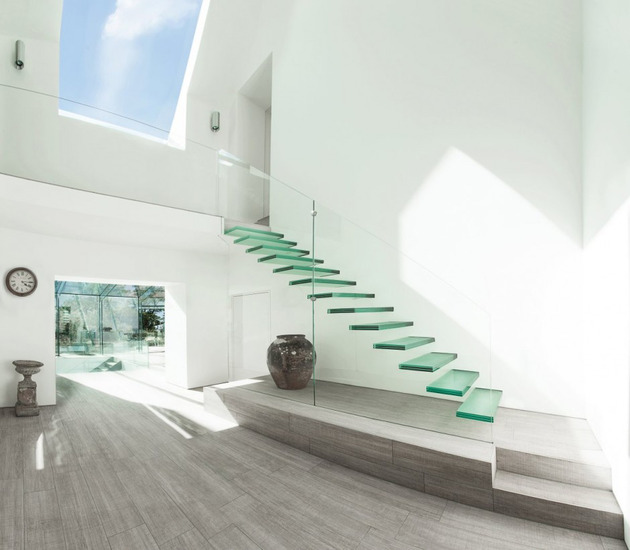The pros and cons of using glass in interior design
Whether glass features in your home architecturally or just decoratively, there’s no denying that it helps the flow of natural light and brings understated style. From bi-folding doors and staircases, to tables, shower enclosures and fireplaces, there’s no end to its uses in our interiors.
The pros
What’s not to like about using glass in our interiors? Its transparency allows light to penetrate our homes, making it ideal for enhancing small or dark spaces. It can frame, highlight and even obscure a view if required. It also allows the eye to travel and explore the space without obstruction.

Bloch Design
Did you even notice the suspended glass fireplace in the image above or did your eyes travel straight to the enviable view showcased by the floor to ceiling glass windows? We rest our case.
Toughened glass can be used for all sorts of applications in the home, such as flooring to open up lower levels or basements, and staircases to allow the continuous flow of light to upper levels.
Often known as floating glass staircases, the mechanics are cleverly hidden in the wall to give the appearance of levitating steps, providing the perfect aesthetic for minimalist interiors.

AR Design Studio
And of course, glass can be coloured, patterned or laminated and provide an interesting focal point to your room or even a decorative sliding door.

Casali
The cons
Obviously the most common issue with glass is the lack of privacy it provides. Depending on where you use it in your home, there are ways around it. Standard uses, such as windows and doors, can be addressed with blinds or curtains to give you the flexibility to obscure the view from prying eyes.
Internal walls or room dividers can be fashioned from glass wall blocks which still allow light in, but distort the view. They can even be used for windows and floors.
And if your frameless glass shower enclosure is visible from your bed, then we’re guessing you don’t have an issue with being admired whilst going about your daily ablutions. If you do, then glass shower enclosures are available that enable you to change the opacity of the glass with a flick of a switch.
Although we don’t consider this a negative, the use of glass, whether it’s decoratively or architecturally, in contemporary designs can add to the cold, clinical feel. And some might even perceive this look to be quite masculine.

Natuzzi
To overcome this and soften the look, introduce a touch of colour and texture with minimal soft furnishings and accessories to balance the design.
Just a hint of glass
Glass comes in all shapes and sizes and can be utilised to add a little design touch here and there, as opposed to making a huge statement throughout your home.
Glass sinks and basins not only add to the clean and crisp aesthetic of modern bathrooms, but allow you to fully appreciate the mesmerising beauty of flowing water.
And for an even subtler approach, glass fronted light switches provide functionality without interrupting the flow of your room’s design. Plus remote and touch control light switches also remove the need for a protruding switch.

Touch Control Light Switch


